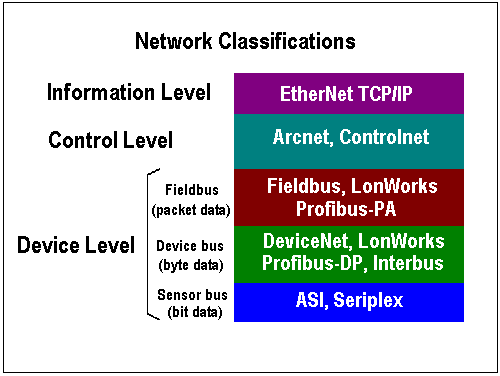|
By : Jim Pinto, ISA Worldbus Journal - Supplement to InTech - October 2000 |

IntroductionThe major “buzz” in the industrial automation business is networking communications on the factory floor and in the process environment: connecting sensors to actuators and everything else in between - programmable controllers (PLCs), I/O, computers, data acquisition, alarms, displays, recorders, controllers. And everyone seems to be waiting for “fieldbus” - the bi-directional communications protocol used to connect field-level instruments and controls.End users expect interoperability as the primary benefit of standardization. But, that remains elusive as vendors push to promote their proprietary differentiation. Even if or when a fieldbus standard is complete and products are available, this will not eliminate the need for other industrial networks for a variety of reasons - cost, speed, complexity, compatibility with already-installed devices and future expansion requirements. Which Bus ?A wide variety of networks is available in the industrial automation environment and confusion arises because their capabilities overlap. At the lowest level are the “sensor” networks which were originally designed primarily for digital (on/off) interface. These are fast and effective, but with only limited applications beyond relatively simple machine-control. ASI (actuator/sensor interface) is still popular in Europe, while Seriplex is a US development.
 At the next level in the hierarchy are the “device” busses - which provide analog and digital support for more complex instruments and products. DeviceNet interfaces very well with programmable controllers; however, it is still only a local, device-level network, operating typically with up to 64 points within about 1,000 feet. Profibus DP and Interbus are somewhat comparable to DeviceNet and are excellent, general-purpose device-level networks. LONWorks operates over greater distances and is currently the only practical peer-to-peer network, extendible to many thousands of points - though it is still comparably slow and more complex. Profibus PA provides improved performance at the “fieldbus” level, for instruments and controls, replacing the features and functions which are provided by HART (originally developed for transmitter calibration and diagnostics). The primary differences are in speed, complexity and distance. LONWorks also extends into this realm. Fieldbus SP-50 overlaps somewhat with Profibus-PA and Profibus-FM, and this is the primary area of contention in the ongoing IEC/ISA SP-50 committee discussions. At the next level we have the “control” networks - which include ControlNet (developed by Allen-Bradley and utilized by Honeywell), clearly overlapping with some of the functionality and performance intended to be provided by Profibus-FMS and Fieldbus SP-50. At the highest level is information and internet connectivity and EtherNet TCP/IP is clearly the standard. During the past year EtherNet is gaining wide acceptance, even at the lower levels, because its performance is well established at the higher end, while commercial proliferation and plummeting prices have extended usage at all levels. The overlap between the various bus-standards is evident and the details are still subject to dispute. The combination of commercial viability and practical time-to-market far outweighs theoretical considerations. The choice is dictated by point-count, physical distances, speed of response, hardware configuration, software requirements, cost and - perhaps most important - interface with other equipment and systems. Typically, a choice of one particular bus causes proliferation until limitations (speed, point-count) are exceeded. This important fact must be noted - no single fieldbus product will emerge as the “universal standard” in the industrial automation environment. It is far more likely that several standards will emerge at the various levels of performance and complexity, in different applications and environments. InteroperabilitySince “inter-operability” between equipment from multiple vendors is a major factor for many users, all the major “open-bus” vendor organizations offer independently “certified” inter-operability - typically through independent third-party test establishments. This directly address the key point - whether or not I/O from vendor A will operate with sensors from vendor B and controllers from vendor C. Typically, the products are certified to work together. However, there may still be difference in speed of operation and other technical features, which still provide proprietary differentiation.Who Will Benefits From Standards ?A "standard" benefits end users - not vendors. Indeed, it is a reasonable and justified objective for any vendor to provide "differentiation", to offer products that produce better profit-margins. Expecting vendors to support a standard that eliminates their advantage is futile. The vendors all support "interoperability" within the standard, and the associations sponsor "interchangeability" between products from different vendors through independent testing. However, the incompatibility between vendor and user objectives will inevitably prolong the confusion until one - or more likely a "few" - networks attain de-facto leadership. Until that leadership is clearly established in the marketplace, conflicting claims will continue to cause confusion.
But that brings with it lots of games The fieldbus wars cause a lot of fuss The Users want an Open bus.
The Vendors simply can’t agree
You’ve gotta read between the lines
De facto standards win all debates 
|
Return to Index of all JimPinto Writings

 Return to JimPinto.com HomePage
Return to JimPinto.com HomePage
If you have ideas or suggestions to improve this site, contact: webmaster@jimpinto.com
Copyright 2000 : Jim Pinto, San Diego, CA, USA
